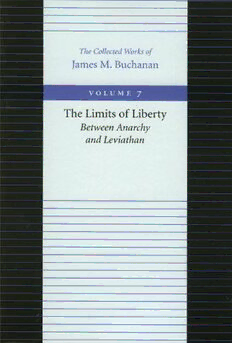
The Limits of Liberty (Collected Works of James M. Buchanan, Vol. 7) PDF
265 Pages·2000·1.137 MB·English
Most books are stored in the elastic cloud where traffic is expensive. For this reason, we have a limit on daily download.
Preview The Limits of Liberty (Collected Works of James M. Buchanan, Vol. 7)
Description:
Published originally in 1975, "The Limits of Liberty" made James Buchanan's name more widely known than ever before among political philosophers and theorists and established Buchanan, along with John Rawls and Robert Nozick, as one of the three new contractarians, standing on the shoulders of Hobbes, Locke, and Kant. While "The Limits of Liberty" is strongly related to Buchanan's "Calculus of Consent", it is logically prior to the Calculus, according to Helmut Kliemt in the foreword, even though it was published later. Buchanan frames the central idea most cogently in the opening of his preface: "Precepts for living together are not going to be handed down from on high. Men must use their own intelligence in imposing order on chaos, intelligence not in scientific problem-solving but in the more difficult sense of finding and maintaining agreement among themselves. Anarchy is ideal for ideal men; passionate men must be reasonable. Like so many men have done before me, I examine the bases for a society of men and women who want to be free but who recognise the inherent limits that social interdependence places on them".
See more
The list of books you might like
Most books are stored in the elastic cloud where traffic is expensive. For this reason, we have a limit on daily download.
